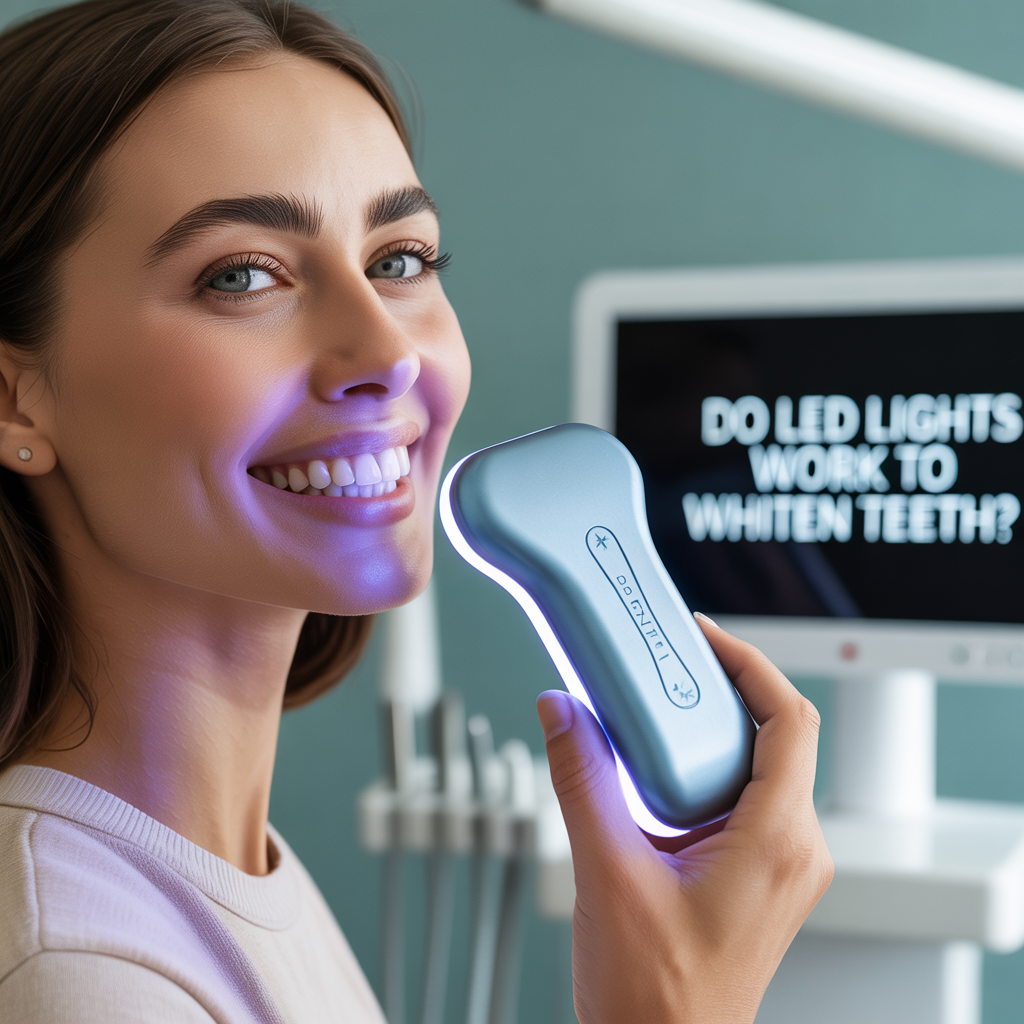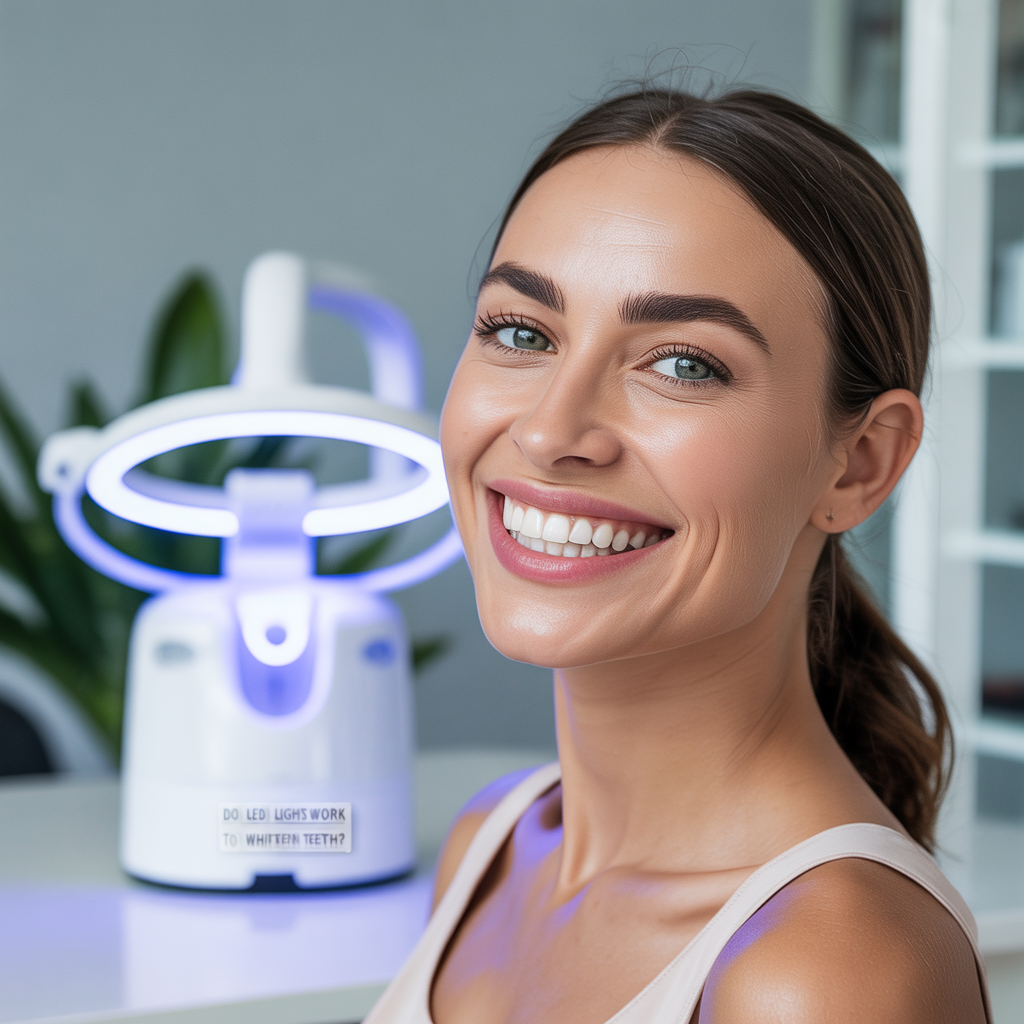Do LED Lights Work to Whiten Teeth? Does It Really Work?
Want a brighter smile without the hefty dentist bill? Many people are turning to at-home LED teeth whitening kits, promising dazzling results. But do LED lights work to whiten teeth? This in-depth guide will explore the science behind LED teeth whitening, its effectiveness, potential risks, and how to choose the right product for your needs….
Want a brighter smile without the hefty dentist bill? Many people are turning to at-home LED teeth whitening kits, promising dazzling results. But do LED lights work to whiten teeth? This in-depth guide will explore the science behind LED teeth whitening, its effectiveness, potential risks, and how to choose the right product for your needs. We’ll also cover comparisons to other whitening methods and answer your frequently asked questions. Get ready to learn everything you need to know before you invest in this popular teeth-brightening trend.
LED lights alone do not whiten teeth. They are used in combination with a peroxide-based whitening gel to accelerate the whitening process. The LED light activates the gel, helping it break down stains more effectively, but without the gel, the light itself has no whitening effect.
Teeth discoloration occurs due to various factors like consuming staining substances (coffee, tea, wine), smoking, and aging. External stains affect the enamel, while intrinsic stains penetrate deeper into the dentin.
LED lights, typically blue light, used in conjunction with whitening gels, accelerate the bleaching process. The blue light activates the peroxide-based whitening agent (usually carbamide peroxide or hydrogen peroxide), breaking down stains and lightening the tooth color. It doesn’t directly whiten teeth; rather, it acts as a catalyst. Think of it as a “turbo boost” for the whitening gel.
Do LED Lights Work to Whiten Teeth?

LED lights can enhance teeth whitening when used with a peroxide-based gel. The light helps activate the gel, speeding up the chemical reaction that removes stains. On their own, LED lights don’t whiten teeth, but they make whitening treatments more efficient and effective.
Read More: Do LED Lights Use a Lot of Electricity? A Complete Guide
How LED Teeth Whitening Kits Work
The Components of a Typical Kit
Most LED teeth whitening kits include a mouth tray (custom-fit or universal), a whitening gel containing peroxide, and an LED light device. The gel is applied to the teeth, and the LED light is activated for a specified time to accelerate the whitening process.
The Whitening Process Step-by-Step
First, you apply the whitening gel to your teeth. Next, you place the mouth tray over your teeth, ensuring proper coverage. Then, you turn on the LED light, usually for 10-20 minutes per session. The process is generally repeated for several days or weeks, depending on the kit’s instructions and the desired level of whitening.
Effectiveness of LED Teeth Whitening
Clinical Studies and Results
While the exact effectiveness varies based on the kit, the initial concentration of peroxide, and individual teeth characteristics, many studies have shown LED light can enhance the whitening effect compared to using the gel alone. However, it’s crucial to remember that the peroxide is the primary active ingredient responsible for whitening; the LED light merely expedites the reaction.
Factors Influencing Results
Individual results can vary widely depending on the severity of staining, the type of stains (intrinsic vs. extrinsic), and the adherence to the product instructions. Genetics and general oral health also play significant roles.
Read More: 11 Creative Bedroom Chandelier Lighting Ideas
Benefits of Using LED Teeth Whitening

Convenience and Affordability
Compared to professional in-office whitening, LED teeth whitening kits offer a more convenient and cost-effective alternative. You can perform the treatment at home, at your own pace.
Gradual and Natural-Looking Results
LED whitening delivers gradual lightening, avoiding the risk of overly bright or unnatural-looking results often associated with aggressive whitening methods.
Painless and Comfortable Treatment
Unlike some professional whitening techniques, LED whitening is generally painless and comfortable for most users.
Read More: Upgrade Your Lighting: A Comprehensive Guide To Can Light LED Conversion Kits
Limitations and Potential Risks of LED Teeth Whitening
Sensitivity and Gum Irritation
Some individuals experience temporary tooth sensitivity or gum irritation. This is often linked to the peroxide concentration in the whitening gel. Using a lower concentration or applying a desensitizing agent before treatment may help alleviate this issue.
Effectiveness on Different Types of Stains
LED whitening may be less effective on deeply ingrained intrinsic stains. For severe discoloration, professional whitening methods are often necessary.
Importance of Following Instructions
Improper use of the kit, such as over-exposure to the LED light or using too high a concentration of peroxide, can damage the enamel and harm your gums.
Comparing LED Whitening to Other Methods
Professional In-Office Whitening
Professional whitening uses much higher concentrations of bleaching agents and powerful lights, resulting in more significant and faster results. However, it is significantly more expensive.
At-Home Whitening Strips and Trays
Whitening strips and trays, often containing peroxide, offer similar results to LED kits but without the light activation. LED light speeds up the process, but it doesn’t dramatically change the final results.
Natural Whitening Methods
Natural methods like oil pulling or using baking soda may offer marginal whitening effects, but they typically take much longer and provide less dramatic results than chemical-based methods.
Choosing the Right LED Teeth Whitening Kit
Factors to Consider When Selecting a Kit
Key factors to consider are the concentration of peroxide in the whitening gel, the type of LED light, the design of the mouth tray, and any added features such as a timer or desensitizing agent.
Reading Reviews and Comparing Products
Before purchasing, always check online reviews and compare different products based on their features, price, and user experiences. Look for kits with positive feedback and a high satisfaction rate.
Understanding the Ingredient List
Pay close attention to the ingredients, ensuring the peroxide concentration is within safe limits. Look for kits with well-researched ingredients and minimal potential for irritation.
Setup and Use of LED Teeth Whitening Kits
Preparing for Your First Treatment
Before you begin, brush and floss thoroughly. Ensure the mouth tray fits comfortably. Apply a thin layer of the whitening gel, avoiding contact with your gums.
Following the Manufacturer’s Instructions
Precisely follow the instructions provided with your kit regarding treatment duration, frequency, and any precautions.
Maintaining Oral Hygiene During and After Treatment
Continue maintaining good oral hygiene throughout the treatment and afterwards. This helps reduce sensitivity and maximizes the results.
Maintaining Your Whiter Smile
Lifestyle Changes to Preserve Results
Reducing consumption of staining substances like coffee, tea, red wine, and tobacco will help prolong the effects of whitening.
Regular Dental Checkups
Regular checkups are essential to monitor the health of your teeth and gums, address any potential issues, and maintain a healthy, bright smile.
Frequently Asked Questions
What are the potential side effects of LED teeth whitening?
Common side effects include temporary tooth sensitivity and gum irritation. These are usually mild and subside within a few days. However, if you experience severe pain or discomfort, discontinue use and consult a dentist.
How long does it take to see results with LED teeth whitening?
Results vary, but you can usually see noticeable changes within a week or two of consistent use. The final results typically become apparent after completing the entire treatment course, as outlined in the product instructions.
Is LED teeth whitening safe for everyone?
Generally, LED teeth whitening is considered safe for most adults with healthy teeth and gums. However, it’s crucial to consult your dentist if you have any pre-existing dental conditions, such as gum disease, sensitive teeth, or dental restorations (fillings, crowns).
How does LED light affect the whitening gel?
The blue light from the LED device activates the peroxide in the whitening gel, speeding up the oxidation process that breaks down stains. It essentially enhances the gel’s effectiveness but doesn’t directly whiten the teeth.
Can LED teeth whitening whiten fillings or crowns?
No, LED teeth whitening only affects natural tooth enamel. Fillings and crowns will not be whitened by the treatment.
How often should I use an LED teeth whitening kit?
Follow the manufacturer’s instructions precisely. Overuse can lead to sensitivity and gum irritation. Generally, daily use is common, but the treatment duration is usually for a specific number of days or weeks.
What should I do if I experience tooth sensitivity?
If you experience sensitivity, reduce the treatment frequency or duration. Using a desensitizing toothpaste or mouthwash before and after treatment can also help. If the sensitivity is severe or persistent, discontinue use and consult a dentist.
Final Thoughts
So, do LED lights work to whiten teeth? The answer is a qualified yes. While the LED light itself doesn’t directly whiten, it acts as a catalyst to accelerate the whitening process when used with peroxide-based gels. LED teeth whitening offers a convenient and relatively affordable way to brighten your smile at home. However, it’s crucial to choose a reputable product, follow the instructions carefully, and understand the potential limitations and risks. Remember to consult your dentist before starting any teeth-whitening treatment, especially if you have pre-existing dental conditions. With proper use and realistic expectations, LED teeth whitening can be a safe and effective way to achieve a brighter, healthier-looking smile.

